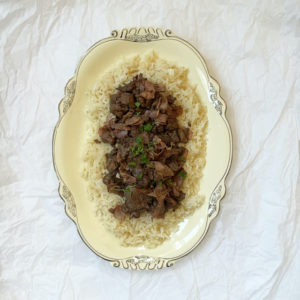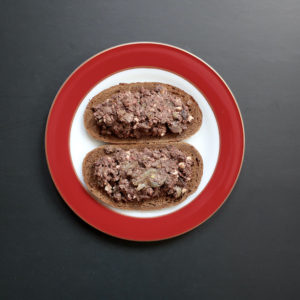Chicken Liver Mousse
We can all agree this holiday season isn’t the merriest. Covid 19 has decimated the population, wrecked the economy, and generally wrought havoc in a shockingly short time. Offering up some fancy dish along the lines of foie gras feels pretty tone deaf…kinda like suggesting $600 is enough to help those in need.

I am suggesting, if possible, that you help out those folks in need, if you can. But you don’t need me hectoring you, right?

Okay, so chicken livers. I made two versions of this, the first being Elizabeth David’s, and while of course it’s impeccable, it’s also very rich. The second version, from Nigella Lawson’s How To Eat, is equally delicious, if more digestible. I give it here, with some alterations.

A few points: I use Kerrygold unsalted butter here, and nobody is paying me to say so. It’s excellent butter, and not expensive.

(Interloper from another picture set. Pretend you didn’t notice.)
I used a combination of Amontillado Sherry and Madeira, as I either have bottles and bottles of Marsala or none at all, and currently I have none at all. But chicken liver mixtures like this work well with sherry, port (which I’m also out of), Madeira, sherry, Vermouth, dry red wine, or brandy, which I added a drop of.

If you prefer not to add alcohol, that’s fine. A few drops of Worcestshire sauce work well here, as does a rinsed, finely minced anchovy.

The mousse must be moussi-fied. To that end, you’ll need either a knife and chopping board, mortar and pestle, or electrified object that does the work for you, like a mini-processor.

To help clean up the inevitable buttery drips, fill a spray bottle with white vinegar and spray liberally before soaping your dishes or wiping down counters. Yes, it’s whiffy, but it works wonderfully, and if your plumbing is cranky, this helps. Who wants to call the plumber now?

Chicken liver mousse is the sort of food that benefits from hanging around a few days, but like our medical professionals, it needs PPE. Spoon your lovely mousse into immaculate ramekins, a loaf pan, or even coffee cups. The ramekins pictured below come from years of collecting; the lids don’t belong to the ramekins. They happily happened to fit.

Whatever you use, make sure your vessel of choice is both heat and cold tolerant. Then, melt the fat of your choosing over the mousse. I used Kerrygold butter.
—
Chicken Liver Mousse, after Nigella Lawson and Elizabeth David
8 ounces/1/2 pound/ 225 grams chicken livers, organic if possible
1/2 lobe shallot
1 small garlic clove
1 teaspoon capers, rinsed if salted
1-2 tablespoons parsley
4 tablespoons sherry, Madeira, Port, dry red wine, marsala, Vermouth, or a combination; I used two tbsp Madeira and two of sherry
dash brandy, optional
1/2 teaspoon unsalted tomato paste
unsalted butter and olive oil, for the pan
1/4 tsp of Worcestshire sauce, optional
1-2 filleted, boned anchovies; eliminate the worcestshire if using.
salt and pepper, to taste
unsalted butter, lard, or duck fat, to cover
You’ll need a mortar and pestle, blender, food processor, or sharp knife and cutting board to make chicken liver mousse. Use the utmost care when handling raw poultry livers, washing all surfaces with hot soapy water. I also fill a spray bottle with white vinegar for cleaning, as it is food safe and cuts grease.
You’ll also need a loaf pan or some small vessels to store the mousse; I used ramekins.
Place the chicken livers in a colander. Place the colander in the sink and run cool water over the livers, rinsing them of any visible blood. Using your clean hands, a small knife, or scissors, carefully remove any green bile sacs, taking care not to rupture them, as the bile is extremely bitter.
There is little fat on chicken livers, but removing any you see is your choice.
Pat the livers dry with paper towels and leave them a moment.
In a small food processor, mortar and pestle, or using a sharp knife, mince the garlic, shallot, capers, and parsley to a paste. Do not clean the processor.
Melt about two tablespoons butter and a tablespoon of olive oil in a sturdy frying pan. I used my Netherton foundry pan, which measures 12 inches/30 cm across.
Once the butter is melted, tip the minced vegetable mixture into your pan and cook it over low heat. You want it to, as Elizabeth David used to say, melt. Meaning, lowish heat, and don’t allow it to brown.
Add the livers to the pan, and cook very gently. Salt and pepper. A little. You can always add a bit more later.
Blood will begin pooling on the surface of the livers. This is your cue to turn them over. It’s also time to add the liquors, Worcestshire sauce, and tomato paste. Stir everything so the flavors can blend. The livers should take 5-8 minutes to cook through. You want them pink. Not red, not gray.
Take the livers off the heat and tip them into a bowl, allowing them to cool a bit before their final puree. If you leave them in the pan, they might continue cooking, and we don’t want that.
Okay. Spoon your livers into the dirty food processor, or chop finely, whatever, but you want a puree here.
Taste for salt, as you’ll be eating this cool or at room temperature.
Chicken liver mousse is the sort of food that benefits from hanging around a few days, but like our medical professionals, it needs PPE. Spoon your lovely mousse into immaculate ramekins, or a loaf pan, or even coffee cups. Whatever you use, make sure your vessel of choice is both heat and cold tolerant. Then, melt the fat of your choosing over the mousse. I used Kerrygold butter.
Allow the mousse to cool, then cover the butter or fat with plastic wrap or foil and refrigerate. Provided the seals are airtight, the chicken liver mousse will keep, refrigerated, up to ten days. Once you break the seal, either consume the mousse within three days or seal it anew with more melted fat.
When it’s time to eat your chicken liver mousse, remove it from the refrigerator about 30 minutes before eating. Eat your chicken liver mousse on crackers, spread in a sandwhich, as a dip, an appetizer, or if you fortunate enough to get truly good rye bread, as deli sandwhich with mustard and dill pickles. Or spring for one of those miniature loaves of black bread and eat it on that.
Do not freeze.

Finally, Happy Holidays, and here’s hoping for a better 2021 for everyone.




